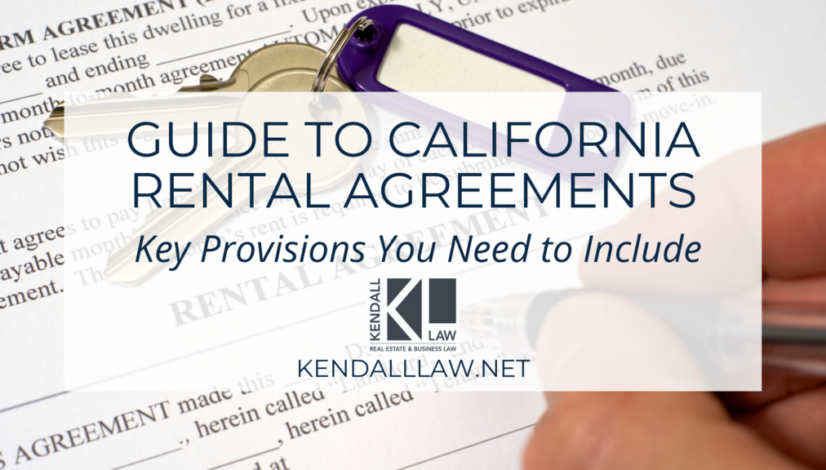Guide to California Rental Agreements: Key Provisions You Need to Include
Renting property in California is subject to a range of legal regulations aimed at safeguarding the rights of both landlords and tenants. To ensure a positive and mutually beneficial landlord-tenant relationship, it’s essential to include specific provisions in rental agreements that adhere to California’s laws and regulations. This article provides a detailed overview of the required rental provisions in California, helping landlords create comprehensive and legally sound rental agreements.
- Identification of Parties: Every rental agreement should clearly identify the landlord and tenant, including their legal names and contact information. This ensures both parties are aware of their contractual obligations and responsibilities.
- Property Description: A detailed description of the rental property, including its address and any specific details that may affect the tenant’s use or enjoyment, should be included. This prevents misunderstandings about the property’s condition or location.
- Rent Payment Terms: Specify the monthly rent amount, the due date, and the acceptable methods of payment. Additionally, outline any late fees, if applicable, and the consequences of non-payment.
- Security Deposit Details: State the amount of the security deposit and explain the purpose of the deposit, including conditions for its return and potential deductions for damages or unpaid rent.
- Lease Term: Clearly state the start and end dates of the lease term, whether it’s a fixed-term lease or a month-to-month agreement.
- Notice Periods: Outline the notice period required for terminating the lease or making changes to the rental agreement. In California, the notice period for termination is typically 30 or 60 days, depending on various factors.
- Maintenance and Repairs: Clearly define the responsibilities of the landlord and tenant regarding maintenance and repairs. Detail how repairs will be handled and the timeframe for addressing maintenance requests.
- Utilities and Services: Specify which utilities and services (e.g., water, electricity, internet) are included in the rent and which are the tenant’s responsibility.
- Entry and Access: Detail the circumstances under which the landlord can access the rental property, ensuring compliance with California’s laws regarding notice and reasons for entry.
- Rules and Regulations: List any specific rules and regulations governing the tenant’s behavior and use of the property, such as smoking policies, pet rules, noise restrictions, and common area use.
- Tenant Rights and Responsibilities: Clearly communicate the tenant’s rights and responsibilities, including obligations to maintain the property, report damages, and abide by the terms of the rental agreement.
- Dispute Resolution: Include a clause outlining the process for resolving disputes, whether through mediation, arbitration, or small claims court, to avoid costly legal battles.
The Risks of Ambiguous Rental Agreements
Legal disputes are challenging to resolve without explicit contractual terms. Omitting these essential provisions from rental agreements can lead to legal vulnerabilities, financial risks, and disputes over property maintenance, tenant rights, and eviction processes.
Non-compliance with local laws may result in penalties. In the absence of eviction-related clauses, the process for removing a tenant due to non-compliance may become complicated and time-consuming. This could result in financial losses for the landlord.
Furthermore, certain provisions are designed to protect the rights of tenants, such as privacy rights and anti-discrimination clauses. Failure to include these may expose landlords to legal action and damage their reputation.
To mitigate these risks, it is crucial to carefully draft comprehensive rental agreements that adhere to applicable laws and regulations, ensuring both parties understand their rights and obligations. Legal consultation and using agreements specific to the jurisdiction can help landlords create robust and compliant rental agreements.
Conclusion
Rental agreements in California should adhere to a comprehensive set of required provisions to ensure a transparent and legally sound relationship between landlords and tenants. By including these essential provisions in rental agreements, landlords can establish clear expectations, prevent misunderstandings, and provide a solid foundation for a successful and harmonious landlord-tenant partnership.
Consulting with legal professionals well-versed in California’s landlord-tenant laws like the team at Kendall Law can ensure that rental agreements fully comply with the state’s regulations. Reach out to the team at Kendall Law today or call 310-619-4941 to schedule a consultation.
Please note that the information provided at this website is intended for general educational and informational purposes only, and should not be construed as legal advice or a substitute for legal advice from a qualified attorney in your jurisdiction.
Author: Eileen Kendall





